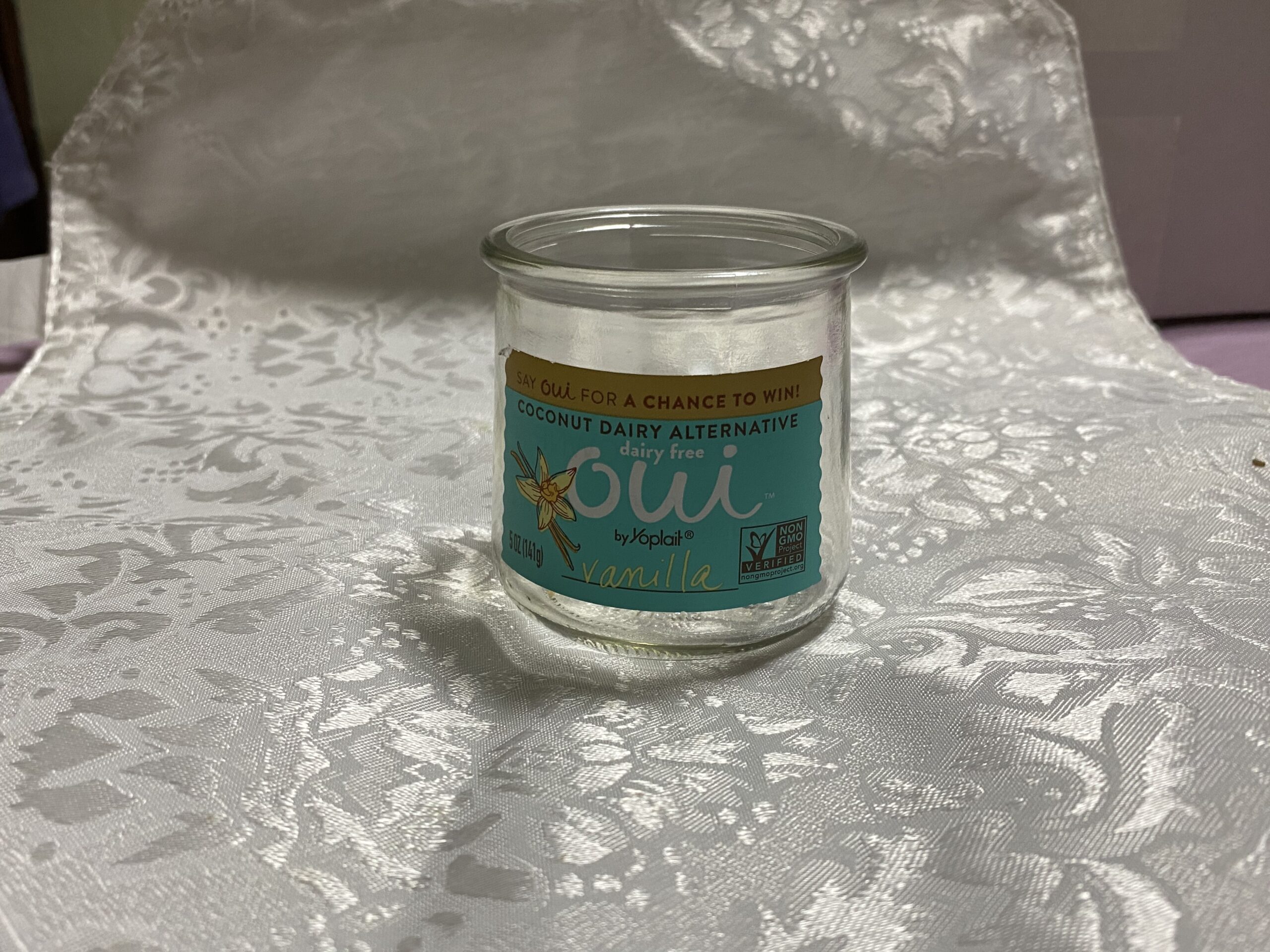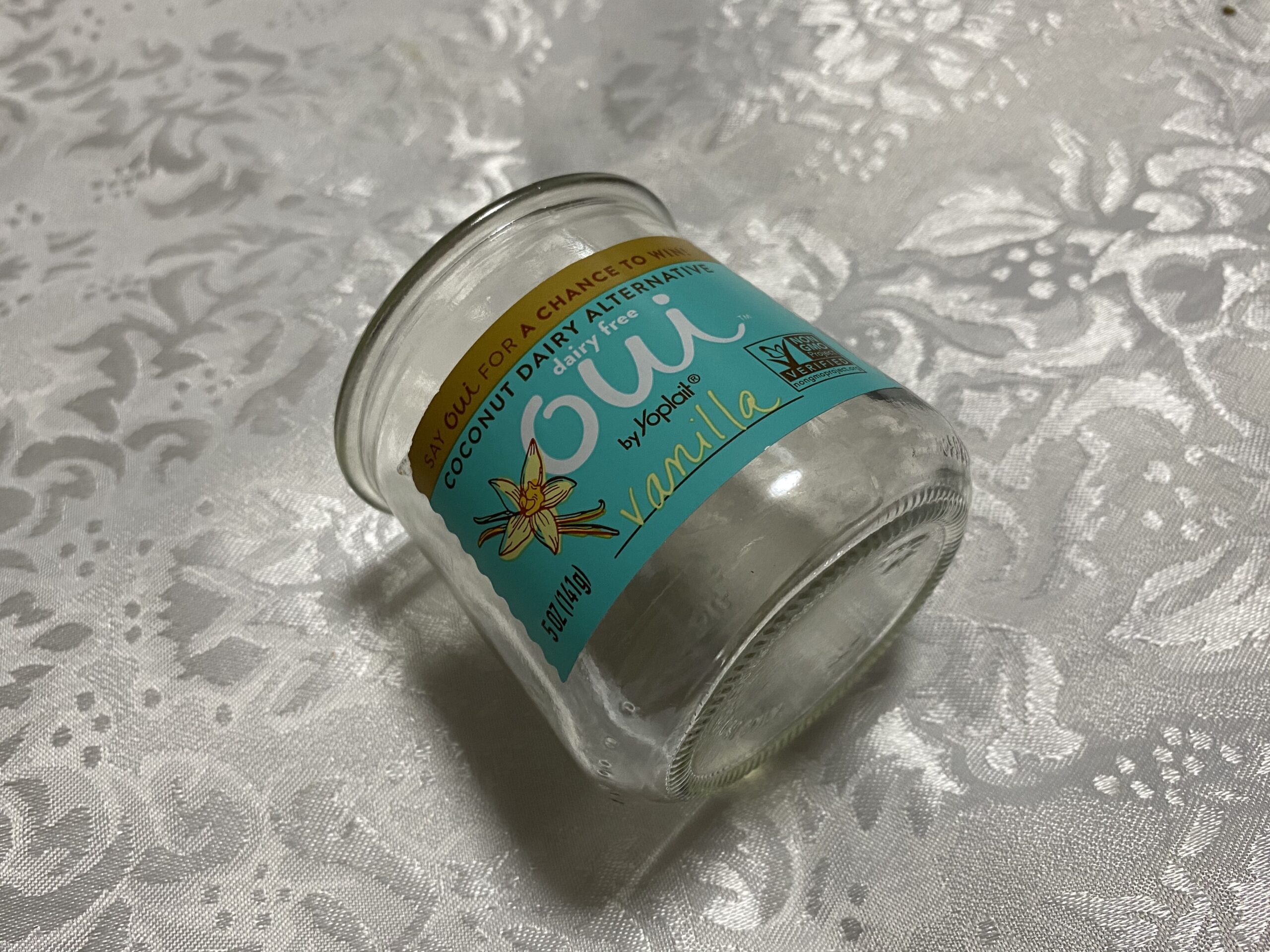5 oz clear glass jar for Oui dairy-free yogurt by Yoplait: 11 ppm Lead + 8 ppm Cadmium. Safe by all standards; full XRF test results in post.
July 23, 2021 – Friday
Introduction:
Tamara Rubin is an independent advocate for consumer goods safety, and she is also a mother of Lead-poisoned children. She began testing consumer goods for toxicants in 2009, and was the parent advocate responsible for finding Lead in the popular fidget spinner toys in 2017. She uses XRF testing (a scientific method used by the Consumer Product Safety Commission) to test consumer goods for metallic toxicants (including Lead, Cadmium, Mercury and Arsenic). To read more about the testing methodology employed for the test results reported on this blog, please click this link.
XRF Test Results for the “Oui” Yogurt Jar Pictured Above
All tests were repeated multiple times to confirm the results.
Reading #1.) Side of the glass jar
60-second reading
- Lead (Pb): 11 +/- 3 ppm
- Cadmium (Cd): 8 +/- 2 ppm
- Iron (Fe): 516 +/- 47 ppm
- Zinc (Zn): 42 +/- 6 ppm
- Indium (In): 8 +/- 3 ppm
- Tin (Sn): 62 +/- 4 ppm
Reading #2.) Rounded bottom edge of the glass jar
60-second reading
- Lead (Pb): 9 +/- 3 ppm
- Cadmium (Cd): 7 +/- 2 ppm
- Iron (Fe): 567 +/- 48 ppm
- Zinc (Zn): 46 +/- 6 ppm
- Indium (In): 4 +/- 3 ppm
- Tin (Sn): 74 +/- 4 ppm
WAIT — DON’T PANIC!
- Many examples of clear glass that I have tested test NEGATIVE for both Lead and Cadmium.
- The levels (of Lead and Cadmium) found here in this jar are not atypical for jars (and bottles) that are sold as food packaging elements. (Here’s a food packaging example with much higher Lead levels in the glass.)
- The levels (of Lead and Cadmium) found in this “Oui” jar are considered to be trace (very low/negligible and – based on current/modern science – would not likely be found to be leaching anything at all).
- For example, the amount of Cadmium that is considered unsafe in an object (in the Country of Denmark – which has fairly strict standards) is anything 75 ppm or higher.
- With Lead (for context), the amount of Lead that is considered unsafe in an item intended for use by children is anything 100 ppm Lead or higher (in the substrate of an object.)
- Even as it relates to those two strictest standards above, the levels of toxicants found in this jar are truly considered SAFE (by ALL STANDARDS) — and I would certainly consider them in the “Lead-safe” range (for a glass jar).
- Newer clear (undecorated) glass is still likely the best thing to store your food in (even with trace / very-low-level toxicants found in some options).
- HOWEVER, most clear (undecorated) glassware products sold expressly for food storage [for instance, this one: https://amzn.to/2WmH19X ] test completely negative for Lead, and may be a better choice than reusing food “packaging” for subsequent other food uses in the home – as I understand many people do with these jars from Oui – anyway. “Safety” has multiple facets — glass containers expressly manufactured for daily service and long-term use are (generally) thicker and/or of higher grade glass, and are often designed and tested to be more resistant to breakage from thermal shock and impacts encountered in daily use over time.
All that said – I understand that the reason these findings may be particularly upsetting to some is that – in the 21st century – we expect our food storage products AND our food packaging to be completely free of potent toxicants like Lead and Cadmium. However, given the high levels of contaminants found in so many brands of baby food recently (here’s my perspective on that concern), it should not be surprising that there is also some level of heavy metal contamination in the packaging of food products (aside from the concern about whether-or-not the contaminants in the packaging are contributing to levels of contaminants in the food.)
A secondary concern: standard business practices
While the baby food industry (as just one example) is busy trying to deflect blame for the contamination of the food — by alleging that the the farmers (and the primary source of the food that makes up the contents of the jars) are to blame… the test results of the food PACKAGING (including glass like this jar) sheds some light on the alternate theory (the more-than-likely truth, actually): the consideration that there is possibly industry-wide processing facility contamination, that is more likely the source of the food contamination (as well as possibly the contamination of the glass packaging). While I do understand the glass is not likely made in the same facility where the food is processed, it is the same industry (the food industry) and industrial standards — which bears operational responsibility for [and – ostensibly – control over / oversight of] these two separate elements — and one could reasonably expect the same levels of permissibility for contamination to exist across the industry (not just specific to actually processing the food).
Some additional reading that might be of interest:
- The post discussing the testing methodology used on this website
- Post discussing how to send in an item for testing
- Things that you can test at home.
- Things that might be better tested with an XRF instrument.
- “Can I test things myself at home?”
Thanks for reading. Thank you for sharing my posts. As always, please let me know if you have any questions and I will do my best to answer them personally as soon as I have a moment (which may not be right away – but I will try!)
Tamara Rubin
#LeadSafeMama
Amazon links are affiliate links. If you purchase something after clicking on one of my links I may receive a percentage of what you spend – at no extra cost to you.
Never Miss an Important Article Again!
Join our Email List











Have you tested the patterned oui glasses as well?